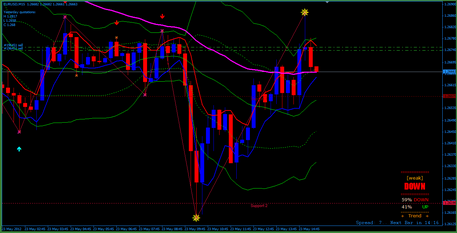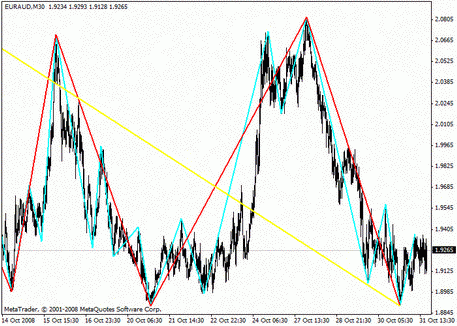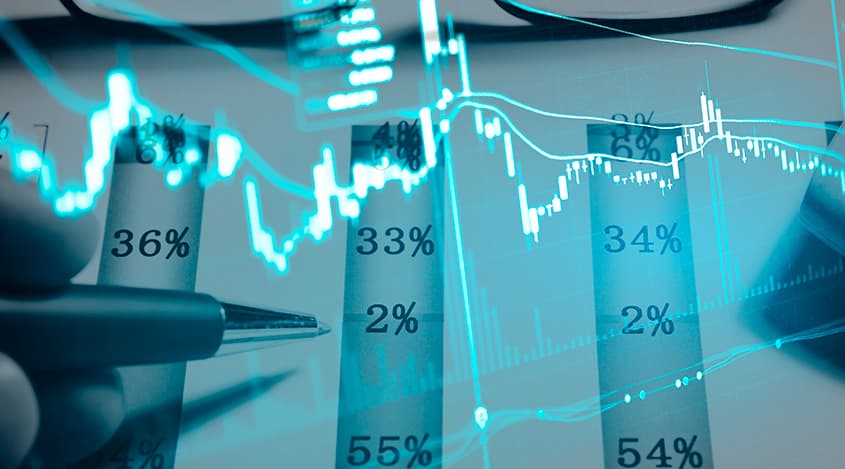
Elliott Waves
The Elliott Waves is a popular tool for technical analysis, the central principle of which is to determine the trend cycles for predicting the future price movements. All the traders have different thoughts about this indicator. Some believe that its signals are ambiguous and without any specifics; others are quite satisfied with the results and regularly use this tool in trading. What caused such different opinions and how to apply the Elliott waves in technical analysis, we will describe further.
Elliott Wave Theory in Forex Trading
The Elliott wave indicators were developed on the basis of the Ralph Elliot wave theory. It is based on the assumption, that any process in the world is cyclical and after every impulse movement, a retreat will definitely take place. That’s why, the scientist singled out 8 waves, 5 of which are impulsive and 3 are the waves of retreats. Their construction is based on the Fibonacci numbers.
This wave model was actively used to predict the prices in the stock market and then it successfully migrated to Forex. In this case, the impulses correspond to the movement of the price in the direction of the dominant trend and the waves of retreat the corrective movements.
The main theses of Elliott's wave theory
Despite the fact, that the development of the trend cycles may differ, there are certain patterns, that we can meet on any cyclical movements. Ralph Elliott singled out these patterns in the form of the basic theses of his theory:
- After each action, there is necessarily the resistance;
- The main cyclical trend always includes 8 waves: 5 impulsive and 3 corrective (model 5/3);
- The impulsive waves are always longer, than the corrective ones;
- The local model 5/3 is a complete cycle and it is fractal, which means, that it is an integral part of the 5/3 model of the next level (of a larger timeframe);
- The 5/3 model is unchanged and only the duration of its formation can vary.
The impulses also have unchanged characteristics typical for the cycles of any duration:
- The second wave of the cycle never crosses the starting point of the first;
- The third wave has the maximum amplitude (it is considered, that the third wave is usually not less, than 62% longer, than the first one);
- The fourth wave never enters the price range of the first one.
These theses help to understand on what stage of the trend cycle is the price at a particular moment and to determine the direction of its subsequent movement.
How to Trade Using the Elliott Waves
The Elliott wave indicators generate signals for buying and selling. The difference lies in the location of the histogram of the indicator (above or below the zero mark). You can trade, using the tips below:
- It is necessary to wait for the moment, when the histogram crosses the zero mark: in a downtrend - from the top to the bottom, and in the upward - from the bottom to the top;
- After crossing the level 0, you must wait for at least one divergence, when the indicator’s indexes will not coincide with the price schedule. If the breakthrough of the zero line occurs upwards, then the indicator should show an upward trend, and if it breaks downward - the downward trend;
- Open a deal, when the correctional wave has passed at least 30% of the previous distance. At the same time, place the stop-loss in the area of the nearest extremum. After reaching this level, pass to the area without losses and move with the help of trailing stop in the direction of the trend, constantly monitoring the situation;
- Close the deal, when the next divergence signal appears in the opposite direction: the indicator falls, when the price chart grows.
The Disadvantages of the Elliott model
The usage of Elliott models in technical analysis makes it possible to clearly define the algorithm of the price movements and the reversal points before the strong movements. However, the accuracy of the forecasts depends on how accurately the point of the primary wave formation was determined. And it is sometimes very difficult to do this - it is difficult to determine, where one wave ends and another begins.
The difficulty in building the Elliott models is that the cycle of trend development can have a different duration - from a minute to several years. In addition, a clear algorithm of price movements corresponding to the Elliott model, can’t always be seen in the real life. At some moments, there may occur the amplitude deviations, disturbances in cycles or difference in the length of individual wave fluctuations.
That’s why, traders don’t use the Elliot indicators alone, but combine them with other technical analysis tools. Most often this role is played by the Fibonacci instruments, which are based on the same numbers. The combination of the Elliott wave model and significant price levels allows to determine the areas of support and resistance. If we add to this tandem a strict money-management, we can achieve good results in the medium and long-term trading. On the short timeframes Elliott waves are ineffective.

 English
English
 русский
русский



